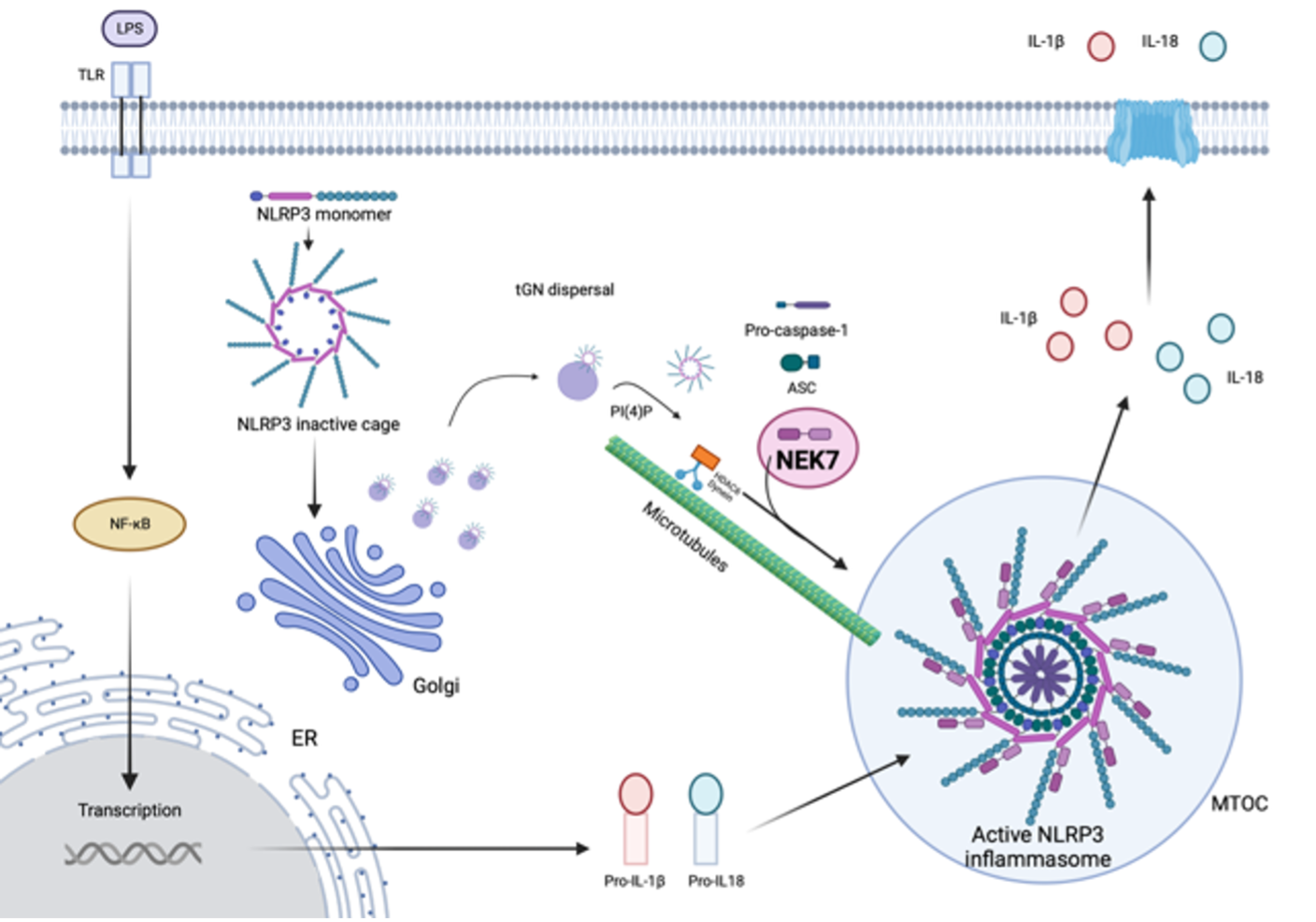Advancing Novel NLRP3 Inflammasome Therapeutics
Halia has applied our extensive structure-based design experience to advance multiple drug candidates to clinical development. Halia’s exciting new therapies are designed to treat severe inflammatory diseases and cancers. Halia’s programs focus on clinically validated novel protein targets that drive the pathogenesis of multiple serious human diseases. Our lead clinical program targets the assembly of the NLRP3 inflammasome through a novel mechanism of NEK7 allosteric inhibition. By blocking the interaction of NEK7 and NLRP3, we prevent the formation of the inflammasome and the downstream signaling that drives immune-inflammatory diseases, hematologic malignancies, and even cancer development.
NOVEL
We have leveraged our core capabilities in targeting the underlying causes of inflammation and neurological diseases to build a discovery engine that has produced a pipeline of novel therapies we are advancing into the clinic.
TARGETED
We are growing to become a leader in targeting the NLRP3 inflammasome through a unique mechanism of action.
INNOVATIVE
We use an innovative approach to drug discovery by translating advances in the understanding of the importance of inflammation in human pathologies such as cancer and neurodegenerative diseases.
Discovering New Meaningful Medicines
Halia Therapeutics is a clinical-stage biopharmaceutical company with a ground-breaking and transformative approach to targeting chronic inflammation. Our pipeline of products allows for treating chronic disease in new ways by turning off the inflammatory signaling at the source. Our team has developed a proprietary approach to inhibit inflammation, which has led to the design of potent and selective, small-molecule allosteric modulators that have shown activity against a broad range of disease models. Halia is led by an expert team of experienced and passionate scientists with decades of experience in drug discovery and development.
We have discovered a quickly growing pipeline of products, with each molecule offering differentiated benefits that potentially address a wide range of chronic inflammatory diseases. This portfolio of unique molecules offers advances in targeting, tissue distribution, and chemical structural diversity.
The Landscape of Chronic Inflammation

Inflammation is an essential biological response of our immune system that protects us against disease. However, when dysregulated inflammation can become a driver of disease by promoting a persistent, systemic immune response that fuels the development of many chronic diseases.
One of the primary mechanisms mediating the persistent, systemic inflammatory response is activating a large protein complex called the NLRP3 inflammasome. The inflammasome activation produces the maturation of pro-inflammatory signaling proteins called cytokines. The increase in the pro-inflammatory cytokines IL-1β and IL-18 resulting from NLRP3 inflammasome activation contributes considerably to disease-causing inflammation.
The Challenge
NLRP3 is an innate immune sensor that is activated in response to a variety of pathogenic and sterile stimuli, including the accumulation of age-associated cell damage proteins. When activated, NLRP3 initiates the formation of the inflammasome, which triggers the release of pro-inflammatory cytokines and initiates a destructive cellular death process known as pyroptosis. NLRP3 hyperactivation has been found to promote the chronic inflammation underlying various disease pathologies across multiple therapeutic areas such as cardiovascular disease, autoimmune disease, neurodegenerative disease, including oncology-related disease.
The Resolution
Halia’s lead compound, HT-6184, represents a groundbreaking approach by specifically targeting NEK7, a key accessory protein that interacts with NLRP3 to activate the inflammasome assembly. NEK7 inhibition through HT-6184 impedes the assembly of the NLPR3 inflammasome complex, effectively stymying persistent inflammation through this pathway. Furthermore, internal data demonstrate that HT-6184 has the capability to deactivate the inflammasome even after its formation.
How We Differentiate
HT-6184 is formulated for oral, intranasal, and ophthalmic administration, for ease of patient use. Due to its high potency, HT-6184 effective doses are predicted to be very low, greatly reducing the potential for drug-induced liver toxicity. Unlike currently approved IL-1b-targeted therapies, HT-6184 targets upstream of the NLRP3 pathway, and not its downstream effector cytokines IL-1b and IL-18. Therefore, the expectation is that HT-6184 will selectively target dysfunctional chronic inflammation in disease tissue, leaving intact the homeostatic acute inflammatory responses needed for daily protective immunity and thereby diminishing opportunistic infection risk.
The Prospect
We envision HT-6184 as a transformative solution for enhancing the well-being of patients dealing with diverse health issues spanning various therapeutic domains. The promising outcomes and favorable evaluation of our clinical data in the Normal, Healthy Volunteer Phase I trial are highly encouraging. Currently, we are embarking on the initial stages of our Phase II initiatives with Myelodysplastic Syndrome (MDS) as the first disease indication in the HemOnc space in India and in the United States in 2024.
The NLRP3 inflammasome: an important and validated drug target
Over the past ten years, many scientific discoveries have revealed the NLRP3 inflammasome as a central upstream activator of the pro-inflammatory cytokines IL-1β and IL-18. NLRP3 has been validated as a viable therapeutic target that may overcome the limitations of many therapeutic strategies researched as treatments for chronic diseases.
Halia’s scientists have made important insights into NLRP3 biology, providing a new path for developing novel treatments for chronic inflammatory disease.

Halia’s Unique Chemical Approach
Halia’s pipeline of compounds was designed and discovered by our scientists by combining a novel protein binding mechanism with physiochemical properties needed for these compounds to be absorbed and distributed to target tissues in the body and even cross the blood-brain barrier. Halia is creating differentiated small molecules to treat chronic peripheral and CNS diseases with meaningful clinical opportunities and impact on patient lives.
Using this novel chemistry approach, we have translated the compounds to demonstrate their activity in assays and in vivo models readying them for clinical development.
Halia’s clinical team is led by leaders with deep expertise and experience in the design and execution of clinical trials to explore the activity of our pipeline of products.
Contact Us
Corporate Headquarters
3900 N. Traverse Mountain Blvd., Suite 100
Lehi, Utah 84043
United States
info@haliatx.com | +1 (385) 355-4315
